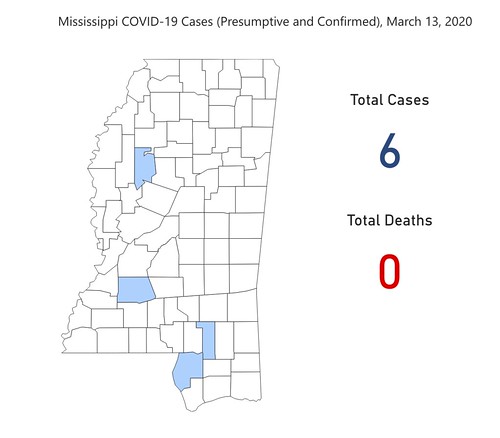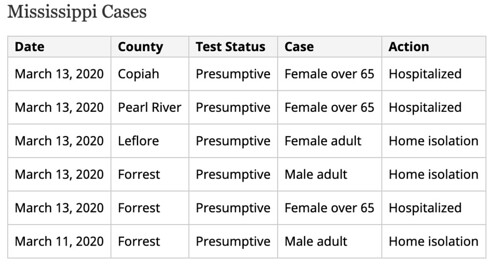
This is going to be a quick post about extrapolation and the importance of “social distancing” with Coronavirus. And I’m going to use Mississippi as a quick example.
The Stats
In Mississippi, it took awhile for the first Coronavirus case to be found. Testing was slow to begin, that is part of the reason. The other part was likely due to people’s reluctance to get tested.

In Mississippi, the test results through March 13th were as follows:
– 1 presumptive case found during the first – roughly – 30 tests tallied
– 2 presumptive cases found during the next – roughly – 10 tests tallied
– 3 presumptive cases found during the next – roughly – 45 tests tallied
Those numbers are based off of the totals up on the Mississippi Department of Health website.

As of March 13th at 11:59pm, the total case count was up to 6 cases out of 90 tests given. That still lines up with the same percentage of positive tests per tests given as the day before. So things, on round three, are still growing just about linearly.
How does extrapolating work?
It gives you a snapshot projection. A forecast based off of limited data. But it shouldn’t be taken at face value.
I was reading up about “community spread” from a mathematician. He was saying that in airborne illnesses the spread within a given area is a lot like a math problem based on probabilities, percentages and ratios.
Once it is here and people are testing positive, there are likely a lot of people who are (1) carrying the virus and (1a) not tested with symptoms, or (1b) not tested without symptoms. And those people then pass it along to others (2) who have the virus and pass it along (2a) with or (2b) without symptoms.
What we are going to do is make a few assumptions and then make a prediction based off of some quick, back-of-the-napkin math. In this case, we are going to assume that not everyone with the virus is getting tested – symptoms or not. And we are going to assume that all counties are ‘in the same boat’ as the four counties that currently have cases.
The Extrapolation of “now” numbers
Mississippi has tested 90 people, finding six with the virus. That means, about seven-percent of people who are tested, have it. And 93-percent do not.
The cases are spread across a few counties. Three in Forrest, one in Pearl River, one in Leflore, and one in Copiah county.
About 75,000 people live in Forrest Co.
About 55,000 people live in Pearl River Co.
About 28,000 people live in Copiah Co.
About 29,000 people live in Leflore Co.
The straight math says that is a total of 187,000 people. With 6 cases. That means that 0.003-percent of the people in those counties have the Coronavirus.
Lets extrapolate that out to the 3 million people in Mississippi. What is 0.003-percent of 3,000,000? That is 100 people.
Not crazy far from my earlier estimation (on facebook) when I used only the Forrest County cases this morning to estimate a total of 126 cases.
That’s just hype, Nick, the real numbers are lower
Yes, the real, tested, numbers are lower. But it is not hype. It is math. This is how extrapolation works, and how local governments prepare for the next round of results. Like I said, we are assuming that not everyone is getting tested – symptoms or not. And we are assuming that all counties in Mississippi are divided up like the four counties we looked at.
“Nick, you know what they say about assuming…”
I do. But in math, sometimes you have to do that for “thought experiments” and extrapolations. While both assumptions are inherently flawed, for many reasons, it still allows us to make a good “first guess” at the number of infected people right now.
Does population density matter?
Perhaps. The population density is just the number of people per square mile of land.
Forrest Co. is about 475 sq miles
Pearl River Co. is about 815 sq miles
Copiah Co. is about 775 sq miles
Leflore Co. is about 600 sq miles
That leaves us with a population density of…
155 people per sq mile live in Forrest Co. (3 cases)
67 people per sq mile live in Pearl River Co. (1 case)
41 people per sq mile live in Copiah Co. (1 case)
48 people per sq mile live in Leflore Co. (1 case)
It looks like there is a bit of a trend. One case per – roughly – 50 people per sq mile density. But this isn’t a lot of data to pull from. So any answer we get should be scrutinized until more data can be collected. The only thing, at this point, the data is good for is to confirm that the more people you cram into an area, the more cases of Coronavirus will be possible. But that isn’t new and should make sense.
Extrapolating from this is no different than pulling 0.003-percent of 3,000,000 people. If you calculate the one-case-per-50 people-per-square-mile, and go county-by-county, you end up at about 90-100 cases.
What this can try to figure out is where all of those cases may be. For example, Jackson has a population density of 1,500 people per sq mi.That is 10 times higher than Forrest county. So, extrapolating out, that would mean 30 cases possibly in Jackson, right now.
But, with such a small sample size, I’m not ready to say that yet. Neither should you.
This is why social distancing matters
This virus may not have dire consequences for everyone. Some people may just get a cough and a fever and move on with life. But, for others, this may mean serious medical issues. And it can spread quickly. As you can see, the math estimates that there are possibly 100 cases in the state. Since the Coronavirus has a two-percent mortality rate, this estimation means that, two people are going to die.
But, that is doing the math for just right now. So, if we all stopped shaking hands, having meetings, going to sporting events, having a beer with friends at a backyard barbecue, etc. there would still be two deaths, based on this extrapolation.
As always, life isn’t that easy, though. The Coronavirus has an R0 value (transmission rate) of 2.2. So one person gives it to 2.2 other people. We will say two for easy math.
So today, if there are 100 cases. And we go forward in time another few days. That gives the people a chance to infect two other people. Then instead of 100 cases, there are 300 cases. Go forward another few days, and now it is possibly 700 cases. Another few days? Up to 1500 cases.
Some (most?) of these will be untested. Most will be mild. But now that two-percent mortality rate becomes even more sobering.
Instead of two people dead. It is 30.
Every next day we wait, can literally kill people. Another few days after 3100 cases? Up to 6300 cases possibly. And that is 126 Mississippians dead. And it would’ve been completely preventable.
That is why sports leagues are shutting down, schools are closing, and businesses are asking people to work from home. Preventative measures to save lives. Maybe not yours, but someone’s.

